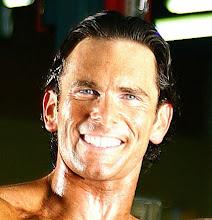
Healthy eating and eating to transform your body are not necessarily the same thing. In order to make significant changes to your appearance (decrease body fat/increase muscle) you have to be really smart about nutrient timing and selection. Simply watching your calories or "eating healthy" is not good enough.
You can see for your own eyes perfect evidence of this in our documentary "I Want to Look Like That Guy". In the first half of the DVD you'll view what we call Phase 1 of the experiment where Stuart follows Max-OT training/cardio with no real attention to nutrient totals. I instructed him to be mindful of his food selections and to make healthy choices but again, with no specific detail.
Over the 18 weeks of Phase 1 Stuart did make progress by dropping fat and increasing muscle but nothing dramatic. The magic didn't happen until we started what I like to call "functional eating" or eating designed to get a specific result. This all plays out in front of your eyes in Phase 2 when Stuart goes from over 30% body fat to less than 6% body fat in a 6 month period.
If you are eating healthy and watching calories but not getting the results you seek you need to examine your nutrition plan. "I Want to Look Like That Guy" gives you a great real world example of how "functional eating" can take your results to the next level.
Believe. Achieve.
http://www.jeffwillet.com/
http://www.iwanttolooklikethatguy.com/



Great article Jeff.
ReplyDelete2 questions that are not entirely related!
Firstly, when one gets to 6% body fat, is it just a question of sticking to your maintenance calorie level to maintain it at that level or do you need to supplement it with weight work and cardio still? I remember Stuart saying he put on 10 pounds in a week after the competition. Is it hard to stay that low?
Secondly, what is the name of those belts you hang weights from while doing dips?
Thanks and KUTGW.
Thank you Jeff! That was very informative and most appreciated as always...I do have some questions though I hope you can shed some light on:
ReplyDelete1/. Why is it called 'functional' eating? I felt Stuart's condition was anything but functional...I noticed he was tired and exhausted all the time. Is it okay to drop down to these caloric levels?
2/. In relation to workouts, I have a general question...if you miss a workout, on your next workout is it better to continue on with the next workout as planned, or do the workout you missed? How did Stuart deal with his workouts when he slipped?
3/. In the documentary I noticed towards the end you asked Stuart to do cardio twice a day ... and asked him to go 'hard'. My question is ... how did Stuart fit in his weight training on the days he did double cardio?
Thank you so much Jeff...
kind regards, Shanx.
1) You need to keep the calorie level low and still maintain your workout routine. You can adjust calories somewhat but that would have to be balanced off with increased cardio frequency. Most bodies do not want to remain that low of BF% so you have to remain very disciplined to maintain such low levels. Often the reason there can be a dramtaic jump in weight after a competition has to do with over eating for a few days on end and gaining a lot of water weight quickly.
ReplyDelete2) I think they are often called Dip Belts or at least that is the slang term I am familiar with.
1) "Functional" in that the function of the nutrition plan is to manipulate body composition. When you go to the extreme to be single digit body fat % it is not functional in terms of physical performance.
ReplyDelete2) If you only miss one day and it is a rare occasion you can just move on to the next workout. If it is a more regular occurnace you can make it up by adjusting the rest of your week.
3) Stu did weights and cardio in the AM and another cardio at some point in the PM.
Thanks :)
ReplyDeleteJeff
ReplyDeleteI'm curious to know what your thoughts are on natural peanut butter. There seems to be alot of hype about it in the mainstream supplement world.
Thanks,
Trent
I don't have any strong opinion about natural peanut butter one way or the other. If you do include it, just be mindful of the calories/amount you are using.
ReplyDeleteReally loved the film.
ReplyDeleteJust a coue of questions I'd love to know
How did you workout how many calories to give Stu initially ?
Did Stu's diet follow a 40/30/30 p/c/f macro ratio ?
Thanks
Stay tuned for a "Behind the Secrets of I Want to Look Like That Guy" video to be released soon and it should help answer this question.
ReplyDelete